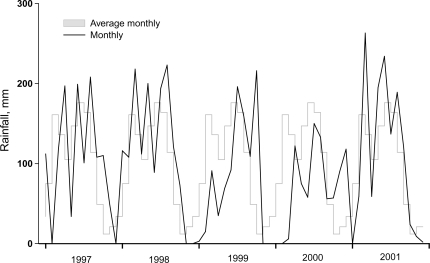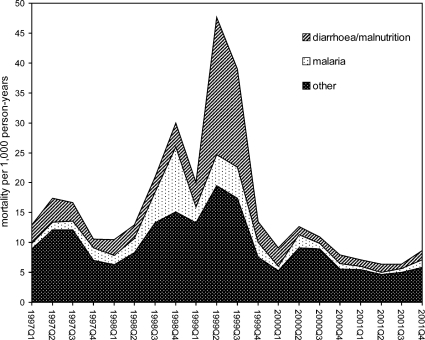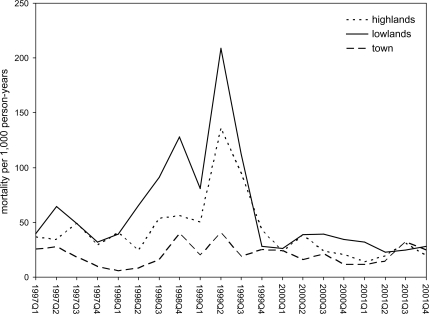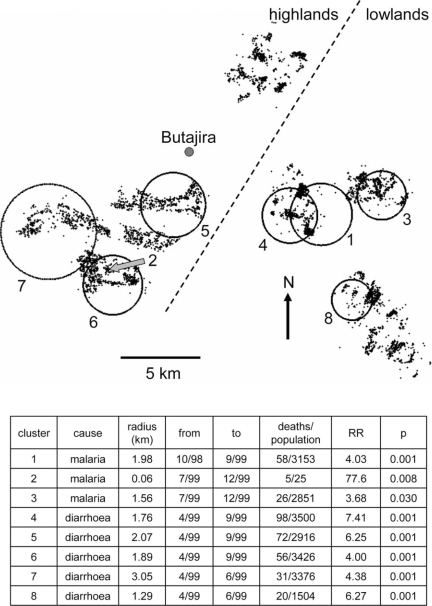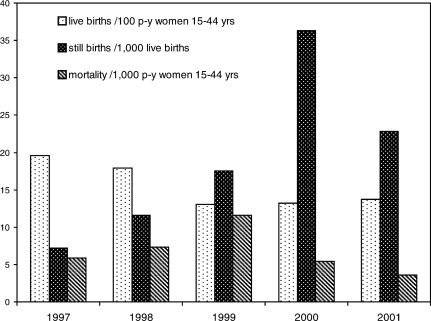Abstract
Background
During 1999–2000, great parts of Ethiopia experienced a period of famine which was recognised internationally. The aim of this paper is to characterise the epidemiology of mortality of the period, making use of individual, longitudinal population-based data from the Butajira demographic surveillance site and rainfall data from a local site.
Methods
Vital statistics and household data were routinely collected in a cluster sample of 10 sub-communities in the Butajira district in central Ethiopia. These were supplemented by rainfall and agricultural data from the national reporting systems.
Results
Rainfall was high in 1998 and well below average in 1999 and 2000. In 1998, heavy rains continued from April into October, in 1999 the small rains failed and the big rains lasted into the harvesting period. For the years 1998–1999, the mortality rate was 24.5 per 1,000 person-years, compared with 10.2 in the remainder of the period 1997–2001. Mortality peaks reflect epidemics of malaria and diarrhoeal disease. During these peaks, mortality was significantly higher among the poorer.
Conclusions
The analyses reveal a serious humanitarian crisis with the Butajira population during 1998–1999, which met the CDC guideline crisis definition of more than one death per 10,000 per day. No substantial humanitarian relief efforts were triggered, though from the results it seems likely that the poorest in the farming communities are as vulnerable as the pastoralists in the North and East of Ethiopia. Food insecurity and reliance on subsistence agriculture continue to be major issues in this and similar rural communities. Epidemics of traditional infectious diseases can still be devastating, given opportunities in nutritionally challenged populations with little access to health care.
Keywords: climate change, famine, mortality, demographic surveillance, epidemiology
Having suffered some apocalyptic famines in the later decades of the twentieth century, Ethiopia acquired a reputation, at least among the international media, of being a land of famine. Fortunately the scale of famine has reduced, perhaps partly due to the end of the civil war in 1991, less widespread droughts, and improvements in water harvesting and storage. However, although famines in Ethiopia are no longer hitting the headlines as they once did, food security remains problematic in some areas and in particular periods. With increasing climate change, the probability will increase of episodes of extreme weather situations, i.e. fluctuations in seasonality and amounts of rainfall. Famine has long been recognised as a result of inequitable distribution, not of an actual shortage of food on a global or even a national scale (1). However, there is still a reason to assume that the human consequences of times of food insecurity or the need of aid are not equitably distributed. These consequences are not generally easy to assess in a society where even most births and deaths go unregistered, and where there is no comprehensive health information system.
Famine in Ethiopia is certainly not a new problem, and particular historical episodes have been documented over a long period (2). Much of the documentation of famine has concentrated on its effects on children (3), but there is also evidence of substantial effects of nutritional stress among older Africans (4). Acute episodes of famine triggering emergency response have been described in terms of morbidity and mortality (5). Famine-associated mortality patterns globally have often been associated with epidemics of infectious disease, such as cholera and malaria, among nutritionally compromised populations (6).
Food insecurity continues to be a problem in sub-Saharan Africa. A national survey by the Ethiopian Central Statistical Authority in 1999, as reported by the International Food Policy Research Institute (7), showed that Ethiopia averages one of the lowest energy per capita per day levels (1,648 kCal) in sub-Saharan Africa, with the majority of the population in a food energy deficient state (76.4%). During 1999–2000, Ethiopia experienced a period of famine due to low and untimely rainfall (8).
The focus of media and organisations has been on pastoralists and semi-pastoralists in eastern Ethiopia. The effects of drought on grazing and on the crops of vegetables and pulses from the small rainy season have been treated as specific to these most drought-prone areas, while the farming communities in the central and western highlands have received less attention (8).
The Butajira Rural Health Programme (BRHP) has maintained a programme of epidemiological surveillance in the Butajira District since 1987 (9), currently named the Meskan and Mareko district, with Butajira town as its administrative centre. Inspection of the BRHP data revealed two peaks of mortality, in 1998 and 1999, well in excess of the normally observed year-to-year variation. Further investigation and enquiry revealed that these related to a serious episode of unseasonal rainfall followed by drought with consequent food insecurity.
The aim of this paper is to characterise the detailed epidemiology mortality of this period, making use of the rare opportunity BRHP affords of having individual population-based data before, during and after the crisis period, on a longitudinal basis. Having access to basic information on household economy we also aim to demonstrate social inequity in vulnerability to climatic events.
Methods
BRHP has operated community-based surveillance on an open-cohort population sample within the Butajira District since 1987. This involved initially selecting a sample of communities within the district using a probability proportional to size method, an initial enumeration of the selected communities in late 1986, and continuous surveillance of vital events by means of household visits (initially monthly, later quarterly) from the start of 1987 (9). The sample includes five highlands, four lowland villages and one of the four administrative units of Butajira town.
Butajira district is located some 130 km to the south of Addis Ababa, in central Ethiopia, and is part of the Southern Nations, Nationalities and Peoples’ Region (SNNPR). The district covers an area of approximately 25×25 km. The mountains of the African Rift Valley rise to some 3,500 m above sea level to the west of the district, while the eastern area is a series of plateaux around 1,500 m above sea level. Consequently patterns of agriculture, which are predominantly based on subsistence crops together with some cash crop production, vary considerably across the district. Malaria occurrence is characterised by high altitude endemicity, with more frequent outbreaks in the lowland areas. Butajira town is centrally located at the interface of the highland and lowland areas, where the main activities are small-scale trading and service industries. Most town dwellers operate within a cash economy, albeit at a very basic level, unlike the more subsistence-based rural economy. Electricity, piped water and hospital services are available to many in the town, but not in the surrounding villages.
As the mortality peak associated with this period of untimely rainfall occurred during 1998–1999, the data analysed here relate to the 5-year period 1997–2001 inclusive, in order to see what happened before and after the crisis. BRHP routine data include all deaths, which are registered at the household level, and the informants’ opinion as to the cause of death. More recently, verbal autopsy procedures have been introduced, giving more detailed cause of death data (9, 10), but for this period, no more details on circumstances and causes of death are available. In this study, cause of death is as reported by the respondents in the routine surveillance. Household locations are known from GPS data, together with basic rural household characteristics such as household water supply and farm land holding, and linked to details of the individual inhabitants. In an attempt to study the socio-economic distribution of mortality, the rural population has been classified according to land holding as living on smaller or larger farms. The unit used in the BRHP data collection is the Ethiopian timad, approximately 0.5 hectares. Based on the distribution itself ‘smaller farms’ are defined as 0–3 timad, and ‘larger farms’ as 4 timad and above.
Monthly rainfall data from the weather station in Butajira for the years 1987–2003 were made available by the National Meteorological Authority. Crop statistics were provided by the District Agriculture Bureau of the Meskan and Mareko District Authority.
BRHP data are managed in a dBase system, which was used to extract the relevant records for this period. The Cohort software (Umeå University) was used for person time-based cohort analysis and Stata (Stata Corporation) for logistic regression analysis. Space-time clustering was modelled using SaTScan v6.1 (11–13).
BRHP research activities have been approved by the National Ethical Clearance Committee and individual informed consent obtained from each participant and/or their parents/guardians.
Results
Average annual rainfall was 1,211 mm for the period 1987–2003. Annual rainfall showed moderate variation over the period for which data were available, from a maximum of 1,471 mm in 1996 to the minimum of 865 mm in 2000. However, monthly rainfall fluctuated considerably more. Fig. 1 shows the rainfall 1997–2001 by month, plotted against the average for each calendar month of the period 1987–2003. The expected pattern has a smaller rainy season around March–April and a larger mid-June to mid-September. While 1997 and 2001 show average patterns with clear seasonality and average totals, the three intervening years are different. In 1998, the total rainfall was approximately 20% above annual average and there was no break between the small and big rains. Both 1999 and 2000 had less than average annual rainfall, 80 and 70% of average, respectively. In 1999, the small rains nearly failed and the big rains began late and went on into the normally dry harvest months, September–November. The rains in 2000 were approximately on season, but the total was low.
Fig. 1.
Patterns of monthly rainfall 1997–2001 and 1987–2003 average rainfall for calendar month.
Unseasonal or low amounts of rain would be expected to influence the crop yields. The main harvest season is in October–November and the yield can be affected both by drought during the growth period in June–September and by rains during the harvest. However, the agricultural production reports to the district Bureau of Agriculture do not show any pattern similar to those of the rainfall data. Data for three major cash crops, maize, teff (an indigenous Ethiopian cereal) and pepper were available for five of the nine rural sub-districts included in the demographic surveillance, from the harvests 1997–2001. Maize shows a drop in yield for the year 1999 but not for 1998 or 2000. Teff and pepper gave average yields in 1998, 1999 and 2000. Overall, there was little variation in the reported agricultural production for the period.
Table 1 shows the mortality experience of the Butajira district population by year, sex age and area. A total of 3,512 deaths occurred in the 5-year period 1997–2001 inclusive, among 222,891 person-years (p-y) of observation, giving an overall mortality rate of 15.8 per 1,000 p-y. However, 1,327 deaths (37.8%) occurred in 1999 and 801 (22.8%) in 1998, giving a mortality rate of 24.5 per 1,000 p-y for 1998–1999, compared with 10.2 per 1,000 p-y in the remainder of the 5-year period. Mortality rates per 1,000 p-y, by quarter for the 5-year period, are shown in Fig. 2, in which the mortality fractions ascribed to malaria and diarrhoea/malnutrition are shown separately. There was no substantial measles outbreak during the period. The mortality peaks in 1998 and 1999 were reflected across all age groups, but were most marked in children under five years of age, who experienced the greatest increase in mortality rates. Deaths among children under 5 accounted for 47.2% of the total. The CDC humanitarian crisis threshold of one death per 10,000 per day (14) was exceeded during the period April–September 1999.
Table 1.
Mortality per 1,000 person-years and number of deaths, 1997–2001 in the Butajira district, by age, sex, geographical area and calendar year
| 1997 | 1998 | 1999 | 2000 | 2001 | |||
|---|---|---|---|---|---|---|---|
| Sex | Age years | Mortality/1,000 p-y (deaths) | Mortality/1,000 p-y (deaths) | Mortality/1,000 p-y (deaths) | Mortality/1,000 p-y (deaths) | Mortality/1,000 p-y (deaths) | |
| Highland | F | 0–4 | 30.9 (48) | 44.8 (72) | 84.4 (131) | 26.8 (41) | 20.2 (30) |
| 5–49 | 6.0 (40) | 8.6 (63) | 14.6 (111) | 5.1 (41) | 2.5 (21) | ||
| 50+ | 43.5 (32) | 36.9 (29) | 117.5 (90) | 30.2 (24) | 10.3 (9) | ||
| M | 0–4 | 44.2 (67) | 42.5 (69) | 79.1 (127) | 26.4 (42) | 21.7 (35) | |
| 5–49 | 6.0 (38) | 9.2 (63) | 13.6 (96) | 4.8 (36) | 2.6 (20) | ||
| 50+ | 49.9 (39) | 32.1 (26) | 88.9 (70) | 31.6 (26) | 17.7 (16) | ||
| Lowland | F | 0–4 | 49.2 (67) | 78.6 (115) | 114.9 (161) | 32.9 (45) | 28.1 (39) |
| 5–49 | 6.1 (32) | 9.5 (55) | 18.5 (111) | 5.1 (33) | 4.2 (28) | ||
| 50+ | 29.5 (15) | 54.1 (29) | 76.0 (40) | 33.5 (19) | 21.4 (13) | ||
| M | 0–4 | 43.9 (61) | 84.0 (127) | 103.4 (150) | 36.1 (52) | 25.7 (37) | |
| 5–49 | 7.1 (36) | 11.7 (65) | 18.8 (109) | 4.4 (28) | 3.0 (20) | ||
| 50+ | 21.8 (13) | 33.2 (21) | 77.3 (48) | 31.3 (21) | 19.3 (14) | ||
| Urban | F | 0–4 | 18.6 (12) | 15.4 (11) | 28.1 (20) | 13.8 (10) | 19.8 (13) |
| 5–49 | 3.9 (11) | 4.3 (14) | 1.9 (7) | 2.8 (12) | 3.0 (14) | ||
| 50+ | 35.4 (11) | 34.1 (11) | 41.8 (14) | 41.7 (15) | 26.0 (10) | ||
| M | 0–4 | 21.9 (14) | 19.7 (14) | 24.1 (18) | 22.7 (17) | 21.5 (15) | |
| 5–49 | 3.5 (9) | 3.4 (10) | 4.8 (16) | 3.8 (15) | 2.3 (10) | ||
| 50+ | 25.1 (6) | 27.9 (7) | 30.3 (8) | 20.5 (6) | 22.4 (7) | ||
| Total | 14.1 (551) | 18.8 (801) | 29.9 (1,327) | 10.1 (483) | 7.1 (351) | ||
Fig. 2.
Overall mortality rates by quarter for the period 1997–2001 in Butajira, showing mortality fractions for deaths reported to be related to malaria and diarrhoea/malnutrition.
Fig. 3 shows how under-five mortality was distributed among the three different ecological zones (rural highlands, rural lowlands and Butajira town). It is evident that the town population was largely unaffected, with only a very minor increase in mortality in 1998. In the following analyses, the town population has therefore been excluded.
Fig. 3.
Under-five mortality rates by quarter for the period 1997–2001 in Butajira.
Most of the excess mortality in 1998–1999 appears to be attributed to either malaria or diarrhoea/malnutrition (Fig. 2). Table 2 shows the results of a multivariate logistic regression analysis investigating the characteristics of rural people who died during 1998–1999 from malaria (n=364) and diarrhoea/malnutrition (n=614), respectively, compared with deaths from all other causes (n=1,000). Malaria deaths were more likely in those over the age of 5 years, while diarrhoea/malnutrition deaths were less likely between the ages of 5 and 50 years. Deaths from malaria were more likely during 1998 and from diarrhoea/malnutrition during 1999 (Fig. 2). Having a protected water supply was significantly protective against diarrhoea/malnutrition deaths. Smaller number of household members was a protective factor against malaria deaths as well as against diarrhoea/malnutrition deaths. Living in the lowland areas increased malaria deaths but possibly protected against dying from diarrhoea/malnutrition.
Table 2.
Factors associated with deaths from malaria (364) or diarrhoea/malnutrition (614) compared with deaths from all other causes (1,000 deaths) in the rural areas of Butajira during 1998–1999. Results from multivariate regression analyses*.
Confidence intervals are corrected for sampling effect of household clustering
| Malaria | Diarrhoea/malnutrition | ||||
|---|---|---|---|---|---|
| Factor | Level | Multivariate odds ratio | 95% CI | Multivariate odds ratio | 95% CI |
| Sex | Female | Ref | – | Ref | – |
| Male | 1.15 | 0.89–1.47 | 0.84 | 0.68–1.03 | |
| Age group | Under 5 yrs | Ref | – | Ref | – |
| 5–49 yrs | 1.73** | 1.32–2.27 | 0.82 | 0.65–1.04 | |
| 50+ yrs | 1.87** | 1.31–2.65 | 1.36** | 1.03–1.80 | |
| Water source | Unprotected | Ref | – | Ref | – |
| Protected | 0.90 | 0.65–1.25 | 0.69** | 0.51–0.94 | |
| Household members | Less than 5 | Ref | – | Ref | – |
| 5 or more | 1.29** | 1.01–1.66 | 1.26** | 1.02–1.56 | |
| Area | Highland | Ref | – | Ref | – |
| Lowland | 1.63** | 1.25–2.14 | 0.80** | 0.64–1.00 | |
*Models including sex, age, source of drinking water, #household members and area.
**Significant at the 95% level.
Space-time clustering analyses were undertaken for the 364 malaria deaths and 614 diarrhoea/malnutrition deaths, respectively, among the 7,411 rural households surveyed. This revealed three clusters with statistically significant raised incidences of malaria deaths and five with raised diarrhoea/malnutrition deaths, as shown in Fig. 4.
Fig. 4.
Space-time clustering analysis of malaria deaths (n=364) and diarrhoea/malnutrition deaths (n=614) among 7,411 households (small dots) during 1998 and 1999 in the Butajira district. All the eight clusters shown represent areas/periods of significantly high mortality, as detailed at the base of the figure.
The differences in rural overall, all-cause mortality between smaller and larger farmers over the period 1997–2001 is shown in Fig. 5 as adjusted rate ratios (RR) for each quarter of follow-up. There are two periods when the mortality gap widens, the RR increase and are statistically significantly greater than 1. The first is in the third quarter of 1998 and the second in quarters 1–3 of 1999. These RR peaks nearly coincide with the two mortality peaks (Figs. 2 and 3), but precede them by one month.
Fig. 5.
Overall, all-cause rural mortality rate ratios, smaller vs larger farms, by quarter, Mantel-Haenszel adjusted, 95% CI.
The consequences of the famine on reproductive health are shown in Fig. 6, for the rural and town population combined. All-cause mortality among women aged 15–44 years in 1999 (11.63 per 1,000 p-y) was more than double that in the remainder of the 5-year period (5.45 per 1,000 p-y, RR 2.14, 95% CI 1.71–2.67), and at the same time a marked drop in birth rate was evident. Still births showed a later peak, in 2000, of 36.3 per 1,000 live births, a rate more than double that in the remainder of the 5-year period (14.6 per 1,000 live births, RR 2.50, 95% CI 1.79–3.48). The BRHP cohort is generally too small for year-by-year analysis of maternal deaths, but there were no obvious trends during this period.
Fig. 6.
Effects of famine on reproductive health indices in Butajira during 1997–2001.
Discussion
There is no question that these analyses reveal a serious humanitarian crisis with the Butajira population during 1998–1999, which also met the CDC guideline definition. Nevertheless, Butajira District at the time did not convey the impression of a population in crisis, nor were any substantial humanitarian relief efforts triggered. The epidemiological analysis reveals that, in common with many historic famines, the direct causes of excess mortality were predominantly diarrhoeal disease and malaria, occurring as two distinct epidemics within the space of a few months.
In the case of the malaria epidemic in 1998, the mortality patterns have to be understood against the complex epidemiological patterns of malaria in highland Ethiopia. Butajira District does not experience the endemic malaria seen elsewhere in Africa, as a result of climate and altitude. The highland areas rarely experience malaria outbreaks at all, but when they do, for example as a result of seeding by gametocytaemic travellers, the effects can be very serious, since there is no substantial immunity in any age group. An extreme example of this is evident from the clustering analysis shown in Fig. 4, where 5/25 residents living within a 60 m radius (cluster 2) died from malaria in one highland village. In the so-called lowland areas, which are still substantially above sea level, there are more frequent outbreaks of seasonal malaria, but relatively low transmission levels and therefore poor individual immunity still mean that there can be considerable all-age mortality as a result. It may also have been the case here that nutritional stress and high mortality increased mobility in the population, either to seek food or attend funeral ceremonies, and this may have exacerbated the spread of malaria outbreaks into the highland villages.
The substantial epidemic of diarrhoeal disease mortality in mid-1999 is notable both for its magnitude and short duration, as well as its drastic effects among children, comparing quarter 2, 1999 to the same quarters before and after (Fig. 3). This is indicative of acute, virulent disease such as cholera or other similar diarrhoeal diseases. Clearly there is no data available on the aetiology of this outbreak, though the substantial survival advantage of protected water sources suggests that it was a water-borne infection. As with malaria, increased mobility at the time may have contributed to the spread of the epidemic from village to village.
For both the diarrhoeal and malarial epidemics, it is clear from the clustering analysis that, as might be expected in relatively short-term epidemics of infectious disease, there were a number of high-incidence areas, while other places were more fortunate. It is notable that neither epidemic took a major hold within Butajira town (Fig. 3), despite being less than 1 km away from a nearby village in which 1 in 40 of the population died from diarrhoea (Fig. 4, cluster 5). Exactly what protected the town is not clear; the availability of better water supplies and housing may have contributed, but it may also have been due to not being part of the subsistence economy to start with, and hence not nutritionally compromised at the time of the epidemic.
The fact that the RR peaks in Fig. 5 precede the mortality peaks in Figs. 2 and 3 may be taken to show that the smaller farmers, at least in the rural areas, respond earlier than those moderately better off to the crisis, with an increasing mortality. ‘Smaller farmers’, with 0–1.5 hectares of land, in the context is mainly subsistence farmers, with no or little surplus crop to trade for cash.
The effects on reproductive indices (Fig. 6) are striking. Evidence from China has linked nutritional stress to increased foetal loss and decreased birth rates (15), but it is not clear in these data why the peak in stillbirths was as late as 2000, nor indeed whether this late peak was an effect of the same cause.
The Butajira area with its location in the central highlands of Ethiopia has not come into focus as a location for the severe famines reported from the northern and eastern part of the country (8). However, it seems likely that the poorest in the farming communities are as vulnerable as the pastoralists in the North and East. Reports of cash crop yields from Butajira villages show little variation over the period 1997–2001. Together with the fact that the mortality peaks in 1998–1999 were minor in Butajira town, this could indicate that it is those who are most unconnected to a cash economy and are most reliant on subsistence farming that experience most of the excess mortality.
A weakness of this analysis is that we have no primary data on nutritional status. The 1999 national survey (7) included regional-level data, which rated SNNPR as one of the lowest in Ethiopia (and in Africa) at that time, with 1,529 kCal per capita per day and 81.9% of the population being food-energy deficient. This is a clear indication of the poor nutritional status in the area at the time, and was measured over several seasons of the year, but does not provide any insight as to how food insecurity might have been changing year by year. On the other hand, these levels of mortality have not been seen at any other time since the inception of BRHP in 1987, which, together with local evidence of drought and famine, suggest that this crisis was a major demographic and health event.
The attribution of cause of death during this period was also not totally robust. However, the large excess number of deaths due to diarrhoea and malaria in a short period of time, as shown in Fig. 2, are not likely to have happened by chance. Death following acute diarrhoea, particularly during an epidemic, is not difficult for relatives to recognise and remember. It could be argued that deaths reported as malaria could be mistaken for other acute febrile illnesses. However, the larger proportion of malaria deaths in lowland areas and the seasonal pattern both add verisimilitude to the data. Measles did not play any major part in the observed mortality rates, probably due to relatively good levels of immunisation. The overall pattern of mortality is also very similar to other famines documented in the past. For example, taking the serious famine that Sweden experienced nationally in 1773, annual mortality rates for the period 1771–1775 were 27.7, 37.6, 53.2, 22.3 and 24.7 per 1,000, closely similar to the experience of Butajira more than two centuries later.
With hindsight, it is also clear that the surveillance system in BRHP should have picked up the excessive rates of mortality at the time, and used the information to trigger appropriate interventions (16). This did not happen, and perhaps demographic surveillance sites (DSS) in general should give more thought to implementing mechanisms for raising immediate alarms whenever, for example, the one death per 10,000 per day threshold in crude mortality is reached (17).
In conclusion, the people of Butajira experienced an insidious yet devastating famine at the turn of the millennium, at a time when most of the world has consigned such events to history. Food insecurity and reliance on subsistence rain-fed agriculture continue to be major issues in this and similar rural communities. Epidemics of traditional infectious diseases can still be devastating, given opportunities in nutritionally challenged populations with little access to health care. More action could and should have been taken in this case, not least by using the surveillance system to flag the emergency. With continuing climate change, episodes like the 1998–1999 may become more frequent, thus increasing the need for weather warning systems to be extended to subsistence farmers as well as for local measures to meet local food shortages.
References
- 1.Sen A. Population and reasoned agency: population growth and food security. Development. 2007;50(S1):98–102. [Google Scholar]
- 2.Webb P, von Braun J, Yohannes Y. Research Report 92. Washington, DC: International Food Policy Research Institute; 1992. Famine in Ethiopia: policy implications of coping failure at national and household levels. [Google Scholar]
- 3.Lindtjorn B. Famine in southern Ethiopia 1985–6: population structure, nutritional state and incidence of death among children. Br Med J. 1990;301:1123–7. doi: 10.1136/bmj.301.6761.1123. [DOI] [PMC free article] [PubMed] [Google Scholar]
- 4.Kigutha HN, van Staveren WA, Hautvast JGAJ. Elderly under nutritional stress: a seasonal study on food consumption and nutritional status in Kenya. Int J Food Sci Nutr. 1998;49:423–33. [Google Scholar]
- 5.Salama P, Assefa F, Talley L, Spiegel P, van der Veen A, Gotway CA. Malnutrition, measles, mortality, and the humanitarian response during a famine in Ethiopia. JAMA. 2001;286:563–81. doi: 10.1001/jama.286.5.563. [DOI] [PubMed] [Google Scholar]
- 6.Macfarlane A. The dimensions of famine. 2002. http://www.alanmacfarlane.com/savage/A-FAM.PDF [cited December 2008]
- 7.Smith LC, Alderman H, Aduayom D. Research Report 146. Washington, DC: International Food Policy Research Institute; 2006. Food insecurity in sub-Saharan Africa: new estimates from household expenditure surveys. [Google Scholar]
- 8.Hammond L, Maxwell D. The Ethiopian crisis of 1999–2000: lessons learned, questions unanswered. Disasters. 2002;26:262–79. doi: 10.1111/1467-7717.00204. [DOI] [PubMed] [Google Scholar]
- 9.Berhane Y, Wall S, Kebede D, et al. Establishing an epidemiological field laboratory in rural areas-potentials for public health research and interventions. The Butajira Rural Health Programme 1987–1999. Ethiop J Health Dev. 1999;13:1–47. [Google Scholar]
- 10.Fantahun M, Fottrell E, Berhane Y, Wall S, Högberg U, Byass P. Assessing a new approach to verbal autopsy interpretation in a rural Ethiopian community: the InterVA model. Bull World Health Organ. 2006;84:204–10. doi: 10.2471/blt.05.028712. [DOI] [PMC free article] [PubMed] [Google Scholar]
- 11.Kulldorff M. A spatial scan statistic. Commun Statist Theory Meth. 1997;26:1481–96. [Google Scholar]
- 12.Kulldorff M Information Management Services, Inc. SaTScanTM v6.1: Software for the spatial and space-time scan statistics. 2006. http://www.satscan.org/
- 13.Ghebreyesus TA, Byass P, Witten KH, et al. Appropriate tools and methods for tropical microepidemiology: a case-study of malaria clustering in Ethiopia. Ethiop J Health Dev. 2003;17:1–8. [Google Scholar]
- 14.Centers for Disease Control. Famine-affected, refugee, and displaced populations: recommendations for public health issues. MMWR. 1992;41:RR13. [PubMed] [Google Scholar]
- 15.Cai Y, Feng W. Famine, social disruption, and involuntary fetal loss: evidence from Chinese survey data. Demography. 2005;42:301–22. doi: 10.1353/dem.2005.0010. [DOI] [PubMed] [Google Scholar]
- 16.Byass P, Berhane Y, Emmelin A, et al. The role of Demographic Surveillance Systems (DSS) in assessing the health of communities: an example from rural Ethiopia. Public Health. 2002;116:145–50. doi: 10.1038/sj.ph.1900837. [DOI] [PubMed] [Google Scholar]
- 17.Fottrell E, Byass P. Public Health. Identifying humanitarian crises in population surveillance field sites: simple procedures and ethical imperatives. in press. [DOI] [PubMed] [Google Scholar]



